By Dan Smith -Genitron.com
My wife doesn't have a problem being around an armed man. In fact, knowing that I'm licensed to carry a concealed weapon, which I always do, gives her a sense of security when she's with me. But, I've had a hard time getting my wife used to actually handling a gun in order to protect herself in case I'm not around. Even the smallest caliber weapon I had in my collection, a .32 auto, seemed too much for her to handle. I had to face the fact that I married a dainty and delicate woman. Should I expect her to be able to handle a handgun of any reasonable caliber?
My range master gave me insight into my dilemma. He told me to start small and take little steps. He recommended that I get my wife a .22 LR caliber pistol to practice with and get used to. In time she could work her way up to more powerful calibers. But to start with, she could much more easily learn to handle a pistol in this smaller caliber.
Now, most everyone will tell you that the .22 LR caliber is not a defensive round, myself included. But I would argue that any gun is a better defense than no gun at all. Additionally, a gun that the user is not afraid of - that the user is comfortable with handling, quickly engaging and discharging - provides a better defense than by a gun that intimidates the user. And, given practice and familiarity of each caliber along the way - .22 LR, .25 Auto, .380 Auto - they can work themselves up to the competent use of even 9 mm or larger handguns, over time.
Of course if you look at the industry's intention for the .22 LR cartridge, you quickly see it is primarily intended for the varmint rifle and match target pistol. And so, you will find very few "defensive" pistols manufactured for the .22 LR caliber. What you will typically find are rather weighty, bull-barrel target pistols that are 7 to 8 inches in length, obviously not designed for defensive situations.
My criterion then for selecting a "defensive" .22 caliber pistol was small size (length around six inches or under), lightweight, reasonable capacity, reliable and affordable, and finally what my dealer had available. What I came home with were the Taurus PT-22, Phoenix Arms HP22 and Walther P22 pistols. Other pistols not tested that fall within this selection criterion would include the Beretta Bobcat, and although closer to seven inches in length than six inches, the Beretta 87 Cheetah, the Bersa Thunder 22 and the Firestorm 22LR, these later products being much harder to actually find.
First up is the Taurus PT-22. Taurus has been making the PT-22 since 1992. This pistol is pretty much a copy of Beretta's Bobcat design with its unique tip-up barrel and dual offset slide recoil springs. But unlike the Bobcat, the Taurus PT-22 is a spurless hammer double-action only pistol. There is a felt sense of quality in the pistol's construction, with solid cast and forged parts and finely tooled surfaces. As with most Taurus pistols, with over 10 variations style isn't lost on the PT-22. The PT-22 is available in matte black, nickel plated or two-tone finishes, with or without gold highlights, and a variety of grips from walnut to mother-of pearl. The model tested here is matte-black with gold highlights and smooth rosewood grips.
Specifications - Taurus PT-22
Action: blowback operated semi-auto
Safety: frame mounted manual safety
Length: 5.25 in
Width: 1.3 in
Height: 4.3 in
Magazine Capacity: 8 rounds
Frame: alloy w/matte black, nickel or two-tone finish
Barrel Length: 2.75 in
Rifling: 6-grooves, RH twist
Trigger: double-action-only
Trigger Pull: ~ 6 lbs
Sights: fixed front blade and rear notch
Grips: walnut, smooth rosewood or mother-of-pearl
Weight with empty magazine: 12.5 oz
Observations -
The most common complaint from dainty women is their inability to rack the slide on even the smallest of semi-automatic pistols. This problem has been resolved by the PT-22's Beretta-style tip-up barrel which allows the first round to be inserted in the chamber without having to rack the slide. Another appealing feature is the unique lever-style dual offset recoil spring assembly which allows the slide to simply snap on and off for extremely easy field-stripping and cleaning. At under 13 ounces, this gun is the lightest of the three guns tested.
The frame mounted safety simply locks the trigger and does not need to be engaged to remove the magazine, although an internal safety keeps the pistol from being fired without a magazine inserted. The finger extension on the magazine provides full grip support for just about any size hand, but the small tang may not protect a larger hand from "slide bite".
While the PT-22 excels in style and manufacturing quality, it unfortunately falls a bit short in function. The gun is stubby and the grips are somewhat fat, particularly for a gun that only holds eight rounds in the magazine. The six-pound double-action-only trigger pull is long and springy making it hard to feel the break. The short four-inch sight radius is not at all helped by the extremely small embedded blade-and-notch sights. All combined, this makes the gun extremely hard to control, and with .22 caliber ammo, you’re going to want all rounds fired to hit their target.
Next up is the Phoenix Arms HP 22. This pistol has been in production since 1994, and since many of the guns in the market were manufactured during the Clinton gun ban, dealers who have this gun in stock may have only 10-round magazines versus the 11-round magazines that the gun is capable of using. The HP 22 has a removable barrel. This is because in the "kit" form this gun comes with the standard three inch barrel as well as an interchangeable extended five inch barrel. Since my criterion was a gun whose overall length was near six inches or less, I was not interested in the "kit".
Specifications - Phoenix Arms HP 22
Action: blowback operated semi-auto
Safety: slide and frame mounted safety
Length: 5.6 in
Width: 1.0 in
Height: 4.2 in
Magazine Capacity: 11 rounds
Frame: alloy, satin nickel or polished blue finish
Barrel Length: 3.0 in
Rifling: 16-grooves, RH twist
Trigger: single-action
Trigger Pull: ~ 4.5 lbs
Sights: fixed front blade and adjustable rear notch
Grips: checkered plastic, hardwood optional
Weight with empty magazine: 20.5 oz
Observations -
Although not the highest quality construction (a lot more stamped parts than I'd like to see, and a bit of uneven nickel plating on the frame) I was otherwise generally impressed with the gun's form and function. About the same length and height as the Taurus PT-22, but not as wide, the HP 22 weighs about 8 ounces more. Although the HP-22 grip circumference is just a quarter inch less than that of the Taurus, its flatter design seems to fit better in the hand.
Like the Taurus, the sight radius of the HP 22 is only 4 inches. But, the contrast between the nickel plated front blade and matte black adjustable rear notch makes aligning the sights with the target much easier than with the Taurus. Disassembly for cleaning is a little more difficult though, involving the removal of the barrel and an open slide recoil spring. There is no recoil spring guide rod.
The single-action trigger hangs loosely in the frame with about a quarter inch of slack take-up before engaging the action. It takes about a 4.5 pound trigger pull to fire the gun. The gun's additional weight helps stabilize recoil. The slide mounted firing-pin safety and hammer spur allow you to safely lower the hammer on a chambered round. The additional frame mounted safety locks the trigger, and must be engaged in order to remove the magazine. Altogether, the flatter grips, contrasting sights, additional weight and single-action trigger pull, make this little gun surprisingly easy to control.
Finally up is the Walther P22. At just a hair over six inches in length this gun just barely makes it into my selection criterion. Form follows function in this pistol, and unlike the rather stylish designs of the Taurus and Phoenix Arms pistols, many people consider the Walther P22 rather ugly. On the other hand the P22's design is much more like that of a larger caliber service or combat pistol, even down to an integrated accessory rail beneath the barrel. This is a much newer gun that began production in 2001 and sports newer features such as a polymer frame and an interchangeable palmswell.
Specifications - Walther P22
Action: blowback operated semi-auto
Safety: slide mounted hammer block, safe decock
Length: 6.25 in
Width: 1.15 in
Height: 5.0 in
Magazine Capacity: 10 rounds
Frame: black polymer
Barrel Length: 3.4 in
Rifling: 6-grooves, RH twist
Trigger: double-action
Trigger Pull: ~9 lbs double-action, ~4 lbs single-action
Sights: white 3-dot combat, adjustable
Grips: integrated polymer
Weight with empty magazine: 16.8 oz
Observations -
This double-action pistol is essentially a scaled down version of its big brother, the P99. Although the largest of the three pistols reviewed here, it is lighter than the Phoenix Arms HP 22, undoubtedly due to its polymer frame. The integrated polymer grip is designed for both comfort and control, and with the interchangeable palmswell, can fit both small and large hands. The sight radius is just over five inches and the large combat-style adjustable 3-dot sights make target acquisition quite easy.
The slide mounted safety lever blocks the firing pin from the hammer and allows you to safely decock the gun with a round in the chamber. An internal disconnect disengages the trigger when the magazine is removed. For a small polymer framed pistol the gun appears well balanced and recoil is negligible. But, the gun's larger size and sharp edges may give opportunity for snagging if used as a concealed carry weapon.
Although the gun disassembles easily for cleaning, reassembly requires a bit more attention. Like larger combat pistols the P22 utilizes a typical slide recoil spring and guide rod combination. In larger recoil-style guns the barrel, recoil spring and guide rod are all usually assembled into the slide, and then the whole assembly simply slides onto the frame. But, since the P22's blowback-style barrel is fixed to the gun's frame, the loose spring and guide rod must be properly aligned under the barrel and compressed together as you attempt to pull the slide into place. Since the uncompressed spring is considerably longer than the guide rod, Walther provides a little plastic extension rod that is slid into the open end of the spring which guides the spring and rod into place as you pull the slide onto the barrel. Reassembly can be very aggravating without that little extension rod, or some other pointed tool to help with the spring alignment.
Conclusion -
In my opinion, the decision here is going to be between the Phoenix Arms HP22 and the Walther P22. The Taurus PT-22 should not even be considered. With an effective range measured in inches rather than feet and its limited capacity, this gun easily makes last place.
The Walther P22 is by far the better shooter and is built with a little more quality than the Phoenix Arms pistol. But, the Walther is large and bulky compared to the HP22. The decision point might then be where the gun is intended to be used. For instance, the larger Walther might be selected for a home defense pistol to be kept in the nightstand, where the smaller Phoenix Arms might be selected for a personal defense pistol to be kept in the pocket or purse.
Although all three guns reviewed cost under $300, the Walther's price is twice that of the Phoenix Arms. So, if affordability is the decision point then the Phoenix Arms might be selected over the Walther.
Personally, I found both the Walther and the Phoenix Arms equally fun to shoot, and for the price... well I'm keeping them both. As far as the Taurus goes... if anyone's interested I'll give you a good deal on it.
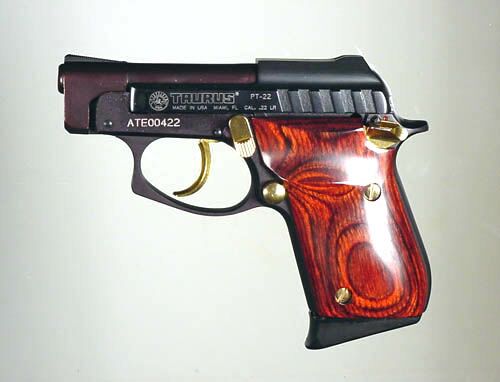
This well-made compact pistol is basically a copy of Beretta's Bobcat design with its unique tip-up barrel and dual offset slide recoil springs. But unlike the Bobcat, the Taurus PT-22 is a spurless hammer double-action only pistol.
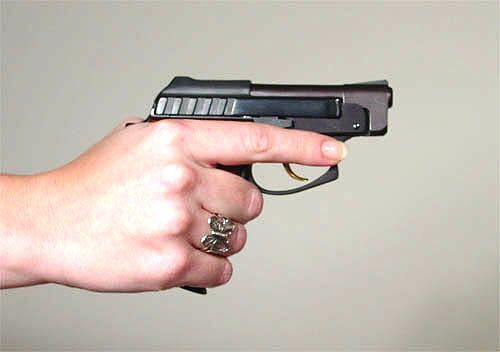
The PT-22 is the smallest and the lightest of the three pistols reviewed. The finger extension on the magazine provides full grip support for just about any size hand, but the small tang may not protect a larger hand from "slide bite".
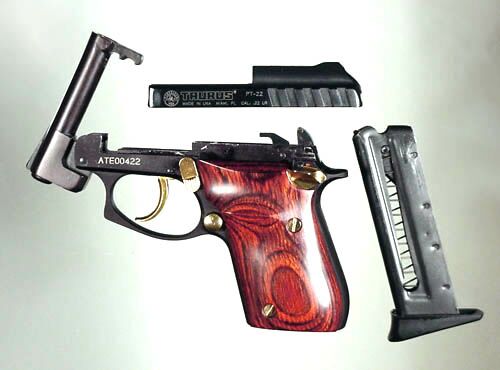
The PT-22 taken down to its field serviceable parts. The tip-up barrel and captive offset slide recoil spring assembly make it extremely easy to disassemble and re-assemble.
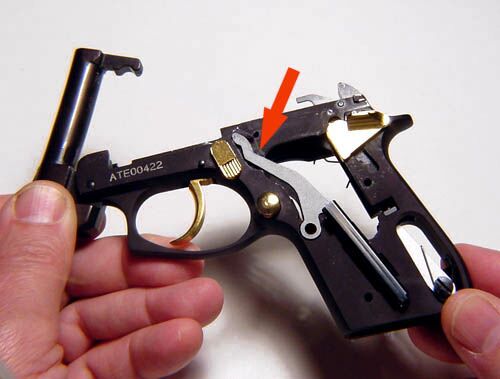
PT-22's slide simply snaps onto the end of a pair of levers on both sides of the frame. Slide recoil moves the levers rearward which in turn compresses captive springs that extend down along each side of the grip area of the frame. Although this makes it easier to remove and attach the slide for servicing, the captive springs along the grip area forces the grip to be uncomfortably wide.
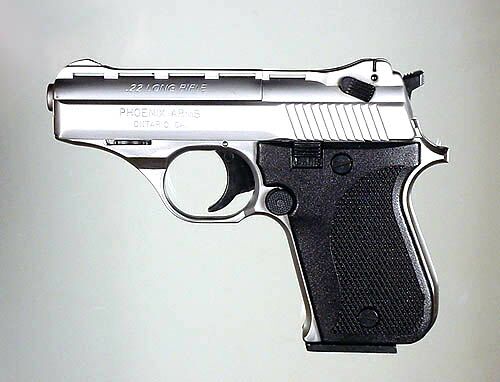
The HP-22 is one of only two models manufactured by this California based company. This extremely affordable pistol has decent reliability and average manufacturing quality. For its price class, it is sleek and stylish and is a pretty straight shooter.
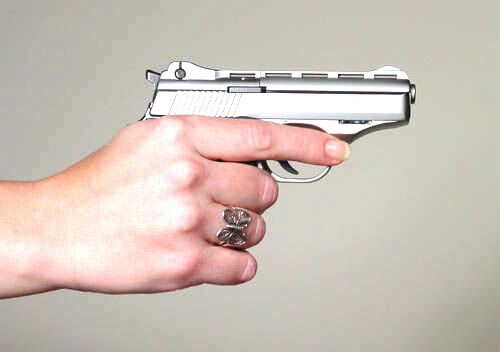
With its short grip and small tang the HP 22 seems to be designed just for a woman's smaller hands. But, it is otherwise a well balanced gun and is suprisingly easy to control.
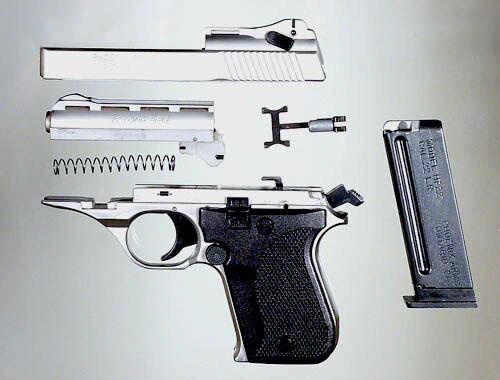
The HP 22 taken down to its field serviceable parts. Disassembly and re-assembly is a little more difficult than the Taurus PT-22, involving the removal of the barrel and managing an open slide recoil spring.
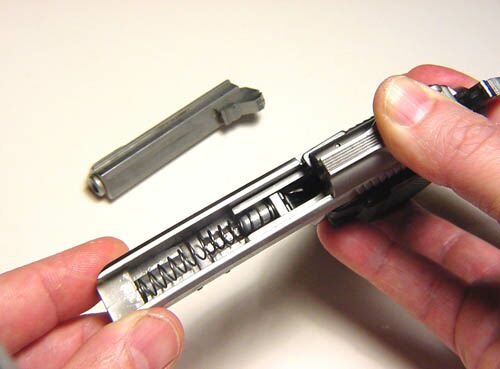
The HP 22 slide recoil spring runs parallel beneath the barrel like most standard semi-automatic pistols, but there is no recoil spring guide rod. Held down by the barrel, the spring simply rides along a groove in the top of the frame. Inserting the barrel can be a bit tricky as you have to retract the slide about a quarter inch. The additional tension on the spring can cause it to fly out while you try to position the barrel to snap it into place.
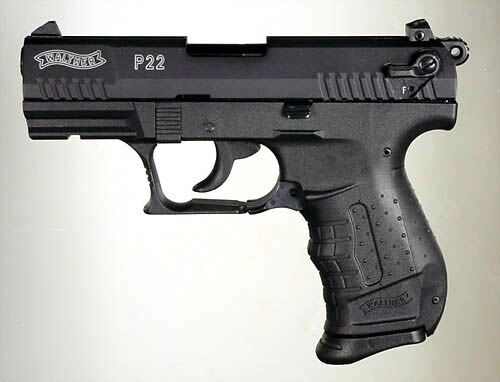
Introduced in 2001, the P22 has many features found in larger caliber modern combat handguns; polymer frame, double-action trigger, interchangeable palmswell inserts, 3-dot combat sights, integrated accessory rail.
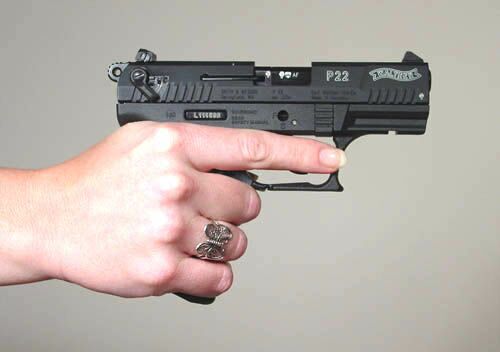
Although the largest of the three .22 caliber pistols reviewed, its light weight, adjustable grip, and easy trigger pull make it a good fit for a small woman's hand.
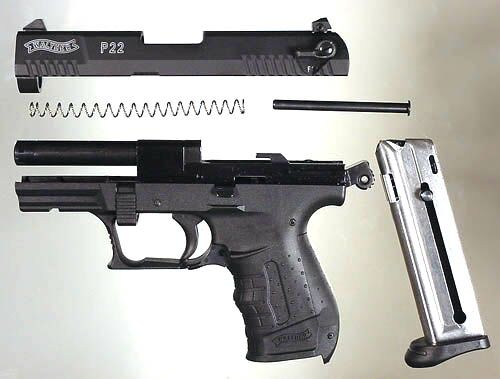
The P22 taken down to its field serviceable parts. An appropriate sized punch is required to remove the pin in the bottom rear of the grip in order to swap out the interchangeable palmswell insert.
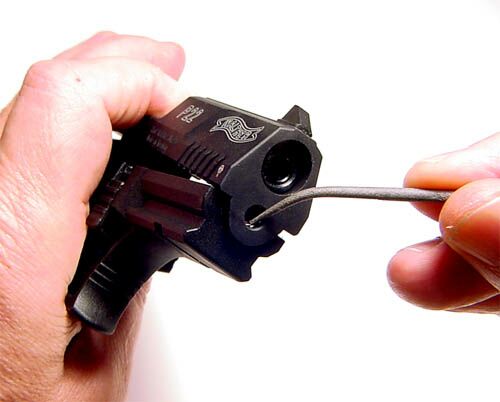
Reassembly of the P22 is relatively easy if you have the guide rod extender that is supplied with the gun. Without it though, you're in trouble. The primary issue is trying to align the recoil spring and guide rod with the bushing hole in the front of the slide while trying to pull the slide onto the barrel and frame. The spring will bind in the bushing hole, not allowing the guide rod to pass though. Without the guide rod extender you will need to use some kind of pointed tool to align the spring.
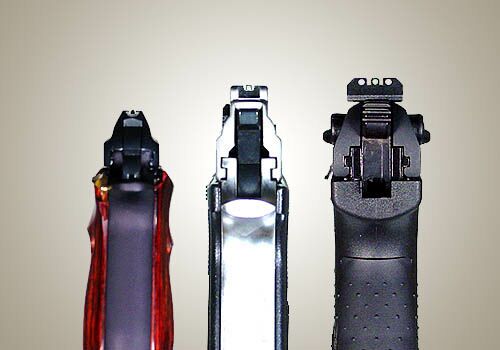
A comparison of the sights on the three pistols reviewed- The Taurus sights were for the most part useless. The Phoenix Arms sights had decent contrast and were much better than the Taurus. But, the Walther 3-dot combat sights were by far the easiest and quickest to acquire the target with.